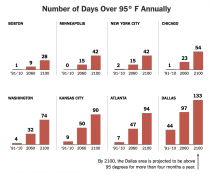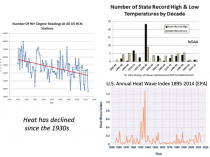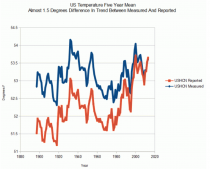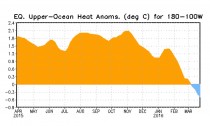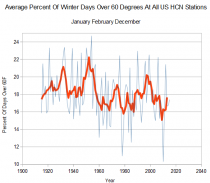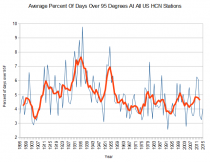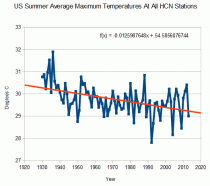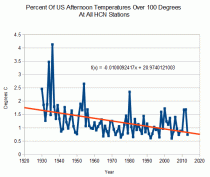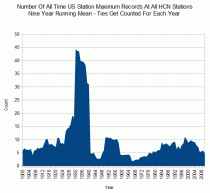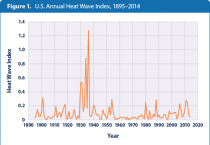Paul Driessen
Hurricane Matthew has given climate change alarmists yet another excuse to rail against fossil use and demand a “fundamental transformation” of the US and world energy and economic systems. Reality simply does not their claims or demands.
Thank you for posting my column, quoting from it, and forwarding it to your friends and colleagues.
Best regards,
Paul
Stormy climate deception
Continued hype and deceit drive climate, energy agenda - clobbering poor families
Paul Driessen
Despite constant claims to the contrary, the issue is not whether greenhouse gas emissions affect Earth’s climate. The questions are whether those emissions are overwhelming the powerful natural forces that have always driven climate fluctuations, and whether humans are causing dangerous climate change.
No Real-World evidence supports a “dangerous manmade climate change” thesis. In fact, a moderately warmer planet with more atmospheric carbon dioxide would hugely benefit crop, forest and other plant growth, wildlife and humans - with no or minimal climate effect. A colder planet with less CO2 would punish them. And a chillier CO2-deprived planet with less reliable, less affordable energy (from massive wind, solar and biofuel projects) would threaten habitats, species, nutrition and the poorest among us.
And yet, as Hurricane Matthew neared Florida on the very day the Paris climate accord secured enough signatures to bring it into force, politicians, activists and reporters refused to let that crisis go to waste.
Matthew is the kind of “planetary threat” the Paris agreement :"is designed to stop,” said one journalist-activist. This hurricane is a “record-shattering storm that is unusual for October,” said another; it underscores how climate change could “turn seasonal weather events into year-round threats.”
What nonsense. What hubris. Suggesting that humans can control planetary temperatures and prevent hurricanes, tornadoes and other severe weather is absurd. Saying an October hurricane augurs year-long chaos is either grossly ill-informed or deliberately disingenuous.
Matthew was a powerful storm that left destruction and death in its wake, especially in impoverished Haiti. Its slow track up the southeastern US coastline pummeled the region with rain, flooding and more deaths. But it was a Category 1 hurricane with 75 mph winds when it made landfall in South Carolina October 8, and a post-tropical storm as it moved offshore from North Carolina a day later.
Despite the rain and floods, that makes a record eleven years since a major (Category 3-5) hurricane last made landfall in the United States (Wilma in October 2005). The previous record major hurricane hiatus was nine years, 1860-1869, according to NOAA’s Hurricane Research Division.
Only a charlatan would suggest that this record lull is due to rising atmospheric carbon dioxide levels. But plenty of alarmist charlatans claim that any violent or “unseasonal” storms are due to “too much” CO2.
Since recordkeeping began in 1851, the US has been hit by 63 Category 3 hurricanes, 21 Cat 4 storms and three Category 5s (1935, 1969 and 1995). Of 51 hurricanes that struck in October, 15 were Category 3-4. Other significant gaps in major hurricane strikes on US coasts occurred in 1882-86, 1910-15 and 1921-26.
The worst periods were 1893-1900 (8 Category 3-5 ‘canes), 1915-21 (8 Cat 3-4), 1926-35 (8 Cat 3-5), 1944-50 (8 Cat 3-4), 1959-69 (7 Cat 3-5), and 2004[05 (7 Category 3-4 hurricanes in just two years).
There is no pattern or trend in this record, and certainly no link to carbon dioxide levels.
Even more obscene than the CO2-climate deception is the response to Matthew’s devastation. More than a week after the Category 4 version of this hurricane struck Haiti’s unprepared shanty towns, hundreds of thousands still had not received food, water, medicine or clothing.
Just as intolerable, United Nations “humanitarian and disaster relief” agencies were issuing “emergency appeals” for $120 million in “life-saving assistance” funds for the desperate Haitians. This after President Obama improperly diverted $500 million from an economic aid program set up to address disease epidemics - like the Zika and cholera cases that are rapidly rising in Haiti - to the UN’s Climate Action Fund. So Obama and the UN blame hurricanes and diseases on manmade climate change, but refuse to spend money they already have on a hurricane disaster, and instead beg for more money. Incredible!
It is clearly not climate change that threatens the poor. It is policies imposed in the name of preventing climate change that imperil poor, minority, blue-collar, farm and factory families.
A new study by the Institute for Competition Economics concludes that Germany’s “green energy transition” will cost 520 billion Euros ($572 billion) by 2025 - just to switch from gas and coal to renewable electricity generation. These costs will keep accumulating long after 2025, and do not cover “decarbonizing” the country’s transportation, heating and agriculture sectors, the study points out.
This 520-billion Euro bill amounts to a 25,000 Euros ($27,500) surcharge for every German family - and 70% of it will come due over the next nine years. That bill is nearly equal to the average German family’s total net worth: 27,000 Euros. It is a massive regressive tax that will disproportionately impact low-income families, which already spend a far higher portion of their annual incomes on energy, and rarely have air conditioning.
Germany is slightly smaller than Montana, which is 4% of the USA, and has just 25% of the US population and 22% of the US gross domestic product. (One-fifth of US families have no or negative net worth.)
All of this strongly suggests that a forced transition from fossil fuels to wind, solar and biofuel energy would cost the United States tens of trillions of dollars - hundreds of thousands per American family.
The impacts of climate change obsession on developing nations would be far worse, if they bowed to President Obama’s suggestions and agendas. African nations, he has said, should “leapfrog” “dirty” fossil fuels and instead utilize their “bountiful” wind, solar, geothermal and biofuel resources. In practice, that would mean having expensive, intermittent electricity and growing biofuel crops on Africa’s nutrient-depleted, drought-stricken lands, with no fertilizer, mechanized farming equipment or GMO seeds.
That is racist. It reflects an elitist preference that the world’s poor should die, rather than emit carbon dioxide “pollution,” drive cars, build modern homes, or engage in other “unsustainable” practices.
Thankfully, few developing countries are listening to such nonsense. Instead, they are using oil, natural gas and especially coal, in ever-increasing amounts, to lift their people out of abject poverty - because the “climate-saving” Paris non-treaty imposes no restrictions on their use of fossil fuels.
But meanwhile, “keep it in the ground” pressure groups are redoubling their efforts to prevent Americans from using their own bountiful fossil fuels to create jobs and prosperity. Even though a new NOAA study confirms that rice growing and meat production generate far more methane than do oil, natural gas and coal production and use - with US operations contributing a tiny fraction of that - these groups use every legal and illegal tactic to block drilling, fracking and pipelines. (Methane is 0.00017% of the atmosphere.)
The dictatorial US EPA nevertheless stands ready to issue tough new methane rules for oil and gas operations, while Al Gore and assorted regulators advocate forcing farmers to control cow flatulence “to combat climate change.” Meanwhile, even Hillary Clinton has recognized that Russia provides millions of dollars in support for anti-fracking and anti-pipeline agitators in Europe and the United States.
Keeping fossil fuels in the ground really means depriving people of reliable, affordable electricity; prolonging unemployment and poverty; having no feed stocks for plastics and petrochemicals, except what might come from biofuels; and blanketing hundreds of millions of acres of farm, scenic and habitat land with biofuel crops, 400-foot-tall wind turbines, vast solar arrays and new transmission lines.
And as the UN’s top climate officials have proudly affirmed, “preventing climate change” is really about replacing free enterprise capitalism with “a new economic development model” and having an excuse to “distribute the world’s wealth” to crony corporatists and other “more deserving” parties.
When taxpayers, consumers, unemployed workers and poor families finally recognize these inconvenient truths, the world will be a far better place - with true freedom, justice and opportunity for all.
Paul Driessen is senior policy analyst for the Committee For A Constructive Tomorrow (www.CFACT.org), and author of Eco-Imperialism: Green power - Black death and other books on the environment.
Anthony J. Sadar
As if natural destruction along the east coast from Hurricane Matthew wasn’t enough, manmade bluster blew into Florida last week in the form of tropical storm experts Hillary Clinton and Al Gore. Of course they blamed the ferocity of the hurricane on “carbon pollution.” That’s a given.
Beyond the cyclonic rhetoric focused on this one dramatic seasonal event, it seems some in the science profession, largely academics, have discovered that they know the future of Earth’s entire climate. Their crystal ball is climate models. Their experience is located in front of a computer screen.
I have been a practitioner in the atmospheric-science community for nearly four decades, working as a weather observer above the Arctic Circle and a field technician in central Illinois, managing high-profile environmental projects and modeling air quality. Over the years, I have interacted with other professionals on the job and at scientific society meetings, especially at conferences of the American Meteorological Society and Air & Waste Management Association.
As an insider, I have heard substantial skepticism of catastrophic global climate change firsthand from experienced meteorologists and practicing environmental scientists and engineers. Generally older professionals are more likely to doubt the current talking points of man-caused climate disaster. After all, older pros, like me, lived through the period in the 1960s and 70s when the coming ice age was all the rage.
Today, the coming sweltering globe is all the rage.
But science is all about perspective. Science includes theory and practice. Academics are typically steeped in theory. Those beyond the ivory towers have pretty much applied theory to practice and so have quite a different take on what atmospheric data are telling us about our future climate.
Meteorologists, humbled so many times by inaccurate weather forecasts, may be the biggest skeptics of climatologists’ confidence in decades-hence global climate outlooks.
And when climatological-type projections that can be verified are examined, they demonstrate good reason to be skeptical.
For example, cycling back to hurricanes, consider the mid-2000s heyday of climate hysteria, the days of Al Gore’s An Inconvenient Truth.
Just prior to the onset of the Atlantic hurricane season in May of 2006, the official U.S. hurricane center forecast stated that it would be another season of unusually numerous events (although not on a par with the record-breaking 31 of 2005, which included 15 hurricanes). However, the forecast was a bust, with only 10 events recorded (5 hurricanes and 5 tropical storms). Keep in mind that in the average year there are about 15 events.
The point is simply this: Forecasting short-term climatic conditions is at least as difficult as forecasting next weekend’s weather.
Subsequent years up to the present day, regardless of long-term expectations and the path of Hurricane Matthew, have wrought little extensive hurricane activity in the U.S.
If the number of severe storm events for a small portion of the globe cannot be accurately predicted, then what are we to make of the substantially more complicated and difficult task of long-range planet-wide climate forecasting?
Earth’s climate is tremendously complex, and though we understand it better today than we did decades ago, we are still a long way from being able to accurately forecast climate conditions decades into the future.
Add to this that crisis-mongering in the form of declaring certain climate doom is harmful to the climate science profession. The mongering runs the discipline like a shady business. And it is particularly harmful to people. It soaks the middle class with higher energy costs and deprives the world’s poor of a better future.
But crisis can certainly serve an over-reaching administration. Government funding targets topics the government has declared critical. These topics attract researchers seeking funding. Conclusions are drawn that support the crisis and the need for further research. And on it goes. Business is booming.
Yet supposed catastrophic climate change from increased carbon emissions as promoted by politicians and the administration is not a fact; it’s a prediction based on a hypothesis. The prediction is a convenient one that is sufficiently nebulous and far enough out (the permanent sweltering of mid-latitude cities by mid-century, for example), that the hyping and embellishing of outrageous prognostications can only be endured, not refuted.
So when headliner climate gurus like Clinton and Gore, along with President Obama, Leonardo DiCaprio and Pope Francis urge immediate action on controlling the atmosphere, an air of caution is advised. Because, when it comes to this dubious climate claim, politicians provide the muscle and money, actors spread the script and clerics preach the Scripture.
As for academics’ confident knowledge of Earth’s climate future - their knowledge is rooted in hubris. And as clerics know, “Pride goes before the fall.”
Anthony J. Sadar is a certified consulting meteorologist, author of In Global Warming We Trust: Too Big to Fail (Stairway Press, 2016), and a contributing writer for The Cornwall Alliance for the Stewardship of Creation.
By David Wojick, Climate etc.
The “Climate Change Education Act” (S.3074) directs the National Oceanic and Atmospheric Administration (NOAA) to establish a climate change education program focused on formal and informal learning for all age levels.
When it comes to beating the climate change drum, Sen. Ed Markey is the Energizer Bunny. As a Congressman, Rep. Markey was Chairman of the now defunct House Select Committee on Energy Independence and Global Warming from 2007 to 2011. This time he is drumming on the education front. Markey has dropped the “Climate Education Act” into the Senate hopper. While the bill is unlikely to pass at this time, it is still important to object to, lest it be seen to be acceptable.

Sen. Markey’s website summarizes the proposal as follows: “The “Climate Change Education Act” (S.3074) directs the National Oceanic and Atmospheric Administration (NOAA) to establish a climate change education program focused on formal and informal learning for all age levels. The program would explore solutions to climate change, the dangers we face in a warming world, and relatively small changes in daily routines that can have a profound global impact. The legislation also establishes a grant program to support public outreach programs that improve access to clean energy jobs and research funds so local communities can address climate mitigation and adaptation issues.”
There is a lot not to like here, beginning with the false scientific claims. The first is hyping the supposed dangers we face in a warming world, which simply do not exist. Nor are there small changes in daily routines that can have a profound global impact, because humans do not control the global climate. What is here being called Education is really just scaremongering and propaganda. Ironically, the Bill itself says one goal is to remove the fear of climate change, which it actually promotes.
What is really strange is the focus on so-called clean energy jobs and technology. The term “clean energy” is a misleading euphemism for renewable technologies. Thus the thrust of the Bill is not just on climate science education; rather it is on using the education system to promote renewables. NOAA has no expertise in this regard and no mission. They do things like running the National Weather Service. Promoting renewables and green workforce development is the Energy Department’s job.
On the science side, NOAA has long been active in so-called “climate education,” which basically means spreading the Government’s biased view of climate change as human driven and dangerous. For example, the Climate Literacy and Energy Awareness Network (CLEAN) Portal was launched in 2010, co-sponsored by NOAA, NSF and the Energy Department. As of 2012, CLEAN has been syndicated to NOAA’s climate.gov portal, where they offer over 600 educational materials, most of which are biased toward the scary Federal version of climate science.
In fact NOAA has led a Federal drive to redefine “climate literacy” as accepting the Government’s biased position. According to their website, the stated Guiding Principle for climate literacy is “Humans can take actions to reduce climate change and its impacts.” The reality is that humans can do little to change climate change and a little global warming is not harmful. It is probably beneficial.
What the proposed Climate Education Act would do is give statutory authority for NOAA’s existing propaganda actions, something that is presently lacking. It also allows the agency to bribe states to use its stuff, which is pretty insidious.
It would also allow NOAA to go beyond simply providing online information, to begin writing actual curriculums to be used in the classroom. That is where the bribery really comes in. This curricular push coincides with the widespread deployment of the Next Generation Science Standards. Most states that adopt them need to develop new curriculums, because these science standards are very different from the existing state standards, especially in the area of climate change.
Beyond this, the Bill would put NOAA into the strange new business of promoting the renewable energy industry and training its workers. The Energy Department already does this, while NOAA has neither the mission nor the organization to do it.
In summary this so-called Climate Education Act does nothing that is good, for the climate or the students. It is based on false science and pushes NOAA in the wrong direction. NOAA should be trying to understand climate change, not promote renewable technologies in the name of dangerous global warming.
----------
Nobel Laureate smashed Global Warming Hoax
Isaac Orr, Townhall
Anti-fracking activists who have been eagerly awaiting the Environmental Protection Agency’s (EPA) Science Advisory Board (SAB) findings on hydraulic fracturing must feel like those kids who rush downstairs to open their presents on Christmas morning, only to find out Santa gave them socks. Instead of determining hydraulic fracturing, commonly called fracking, to be dangerous, as the activists hoped, SAB essentially confirmed the conclusions of EPA’s draft study, which found no evidence hydraulic fracturing has had widespread or systemic impacts on groundwater resources but wants EPA to show more data to back up these claims.
Fracking opponents had been hoping SAB would recommend the headline conclusion “hydraulic fracturing had not led to widespread, systemic impacts on water quality” be removed from the report. Instead, SAB stated if EPA retains this conclusion, it should provide a quantitative analysis that clearly supports the claim fracking is not having a widespread impact on water resources. This statement amounts to what our math teachers always told us: “I don’t care if you have the right answer, show your work.”
This is exactly the sort of recommendation a science advisory board should make, because in science, one cannot simply show the conclusion without explaining the methodology or presenting the evidence that led to that conclusion. And when it comes to fracking, the quantitative evidence shows environmental impacts are rare and the risks associated with this practice are manageable.
Evidence supporting the safety of fracking is abundant. Recent data from the Pennsylvania Department of Environmental Protection found absolutely no confirmed cases of stray methane migration in the Keystone State in 2015 and only five such cases in each of the two preceding years. This comes at a time when thousands of wells were drilled in the state (785 wells in 2015 and 1,373 in 2014). This means, incredibly, 99.77 percent of the wells drilled in Pennsylvania during the past two years have had zero leaks. This is the kind of quantitative analysis that can help people understand the risks associated with fracking.
A study published earlier in 2016 by the University of Cincinnati investigated the impact of fracking on water supplies in five Ohio counties over the course of three years. It found fracking had no effect on the quality of water. Similarly, a study by Yale researchers analyzed the impact of fracking on water supplies and concluded fracking does not contaminate drinking water. There are dozens of other studies that reach similar conclusions, making the hopes of activists who want to ban fracking look, at best, bleak.
It seems as though some of the most vocal opponents of fracking were hoping EPA is so lazy it would decide to retract its headline conclusion rather than supply quantitative evidence to support it. In an interview given for an article published by NPR’s StateImpact, a representative from Food and Water Watch said, “[The new SAB report] makes clear that EPA could scrap the language altogether and avoid this issue of having to quantify widespread systemic impacts.”
If anti-fracking crusaders are so confident additional data would support their position, they wouldn’t need to hope for a lazy EPA.
SAB also encouraged EPA to discuss high-profile cases such as Pavilion, Wyoming and Dimock, Pennsylvania in which the public has expressed specific concerns about potential contamination. In Pavilion, Wyoming, state environmental regulators found EPA did not use proper methods to test for whether fracking had contaminated the water there, and further investigation conducted by the Wyoming Environmental Quality Board concluded fracking chemicals had not contaminated groundwater. In Dimock, Pennsylvania, a jury awarded a large settlement to a family suing a natural gas driller, even though the legal counsel for the family admitted there is no proof fracking fluids had entered the water.
An in-depth discussion of these two case studies would help to inform the public and alleviate the considerable confusion that still exists about whether fracking has impacted drinking water sources in these areas.
SAB was tasked with reviewing EPA’s draft study, which examined over 3,500 sources of scientific information, and providing recommendations. Like all good scientists, SAB effectively said, “Show me the data,” and hopefully, EPA does just that, because people living in areas where fracking is taking place - or could take place in the future - deserve to have a data-driven explanation of the actual risks of fracking, not more misinformation from anti-fractivists.
See how emails expose how green groups colluded with EPA on regulations and even fund raising here.
Heidi Cullen, Climate Evangelist, New York Times
July wasn’t just hot - it was the hottest month ever recorded, according to NASA. And this year is likely to be the hottest year on record.
Fourteen of the 15 hottest years have occurred since 2000, as heat waves have become more frequent, more intense and longer lasting. A study in the journal Nature Climate Change last year found that three of every four daily heat extremes can be tied to global warming.
This map provides a glimpse of our future if nothing is done to slow climate change. By the end of the century, the number of 100-degree days will skyrocket, making working or playing outdoors unbearable, and sometimes deadly. The effects on our health, air quality, food and water supplies will get only worse if we don’t drastically cut greenhouse gas emissions right away.
---------
A reality check shows as usual, Heidi and her cult followers are wrong.
You can see the number of 90F and 100F days and heat waves have declined since the 1930s. Indeed of all the state all-time record highs, 23 occurred in the 1930s, 38 before 1960 and there have been all-time state lows than highs since the 1940s.
You can see the number of 100F days for all stations have declined. But the warmists don’t look at actual data just their models which have failed miserably because their theory is bogus - 100% politically driven.
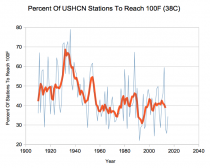
Enlarged
BTW, the highs and lows are unadjusted data. the graphs they love to show you are adjusted - homogenized by blending the bad data into the good stations instead of adjusting the bad UHI contaminated station data with the accurate rural area. They have inexplicably cooled off the past decades to make cyclical warming more worrisome. They can’t do it with the record highs and lows which reside in too many other places and would expose their devious ways. Pass it on.
Joe Bastardi
This chart says some important things. From a tweet by Roger Pielke Jr.:
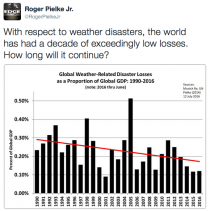
A few points:
Relative to GDP, costly weather disasters are going the opposite way of what is being said by people cultivating apocalyptic fear over anthropogenic global warming. For instance, we know that longevity of life is increasing on the planet, but more people are dying now than they did a century ago. Why? Simple: There are more people on the planet. The global population stood at 1.6 billion people in 1900. There are 7.3 billion people today. So, historically, it is true that more people are dying today. It may even be true that more people are affected by bad weather than ever before. In fact, that should be intuitively true since there are close to 5.5 billion more people. But relative to population and property, losses have been decreasing, not increasing!
It is obvious that Al Gore took the Katrina-year-driven anomaly and used it, along with the bulk of the rest of the AGW hysterics, to continue what is a false missive. There is certainly no increase in weather related disaster costs as a proportion of the GDP. Yet no one seems to want to address this or call anyone to account.
The hard fact is that a warming world may lead to less, not more, weather related disasters, though with more people and property in the way every extreme event is capable of causing more damage. Imagine the 1938 hurricane hitting New England today, for example.
But there is a physical reason for why a warming world would mean less, not more, severe weather in the larger picture. The answer lies in where it’s warming and when.
See more of the answers here.
Pierre Gosselin, No Tricks Zone
The oceans (SST) have cooled surprisingly over January to February 2016.
While during other El Nino events like in 2015/16 led to a time-delayed warming of the Earth’s atmosphere - as was the case this year, the global oceans have decoupled themselves from this time-delayed warming and are showing a surprising significant cooling from January to February 2016 when compared to the powerful 1997/98 El Nino event:
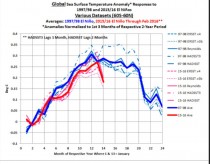
Enlarged. The plot from BOB TISDALE shows the course of the SSTA during the powerful 1997/98 El Nino and from 2015/16. The monthly mean SSTA from multiple data suppliers show a surprising drop in global SST in February 2016. Source: Global Sea Surface Temperature Responses to the 1997/98 and 2015/16 El Nino Events.
The North Pacific, which since 2014 had been parked off the west coast and known as the warm BLOB, saw the greatest share of the global sea surface cooling. By December 2015 it practically disappeared:
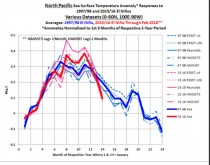
Enlarged. The plot from BOB TISDALE shows the course of the North Pacific SSTA during the powerful 1997/98 El Nino and 2105/16.
Global temperatures fell in March 2016
In March 2016 the global temperatures have shown a clear retreat after their three to four-month highpoint February 2016, time delayed after the El Nino peak at the end of October/start of November 2015. This has also been the case in the tropics as well:
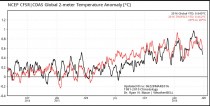
Enlarged . The plot shows the measured/calculated temperature deviation global (black curve) and in the tropics (red curve). After a peak in February 2016, global temperatures have fallen sharply as of 28 March 2016. Source.
Therefore it is fully possible that the global temperatures have already begun to gradually ease back from the previous month’s record high in February 2016, although this was not expected to happen until April: Record warmth in the troposphere in February 2016, Tropical sea surface starts to cool off.
“...With increasing cooling of the tropical sea surface, this means also a gradual cooling of global temperatures will set in by April 2016, which I described here: ENSO update February 2016: El Nino leaving- La Nina arriving...”
Also see the unfalsified facts: “Global Warming” Reality Check February 2016: The global warming “pause” since 1997 continues- RSS 0.94.”
The water masses of the equatorial Pacific over the past months have released a considerable amount of energy into the atmosphere. From the end of October 2015 until the end of March 2016, the upper 300 meters have cooled strongly: by 2.6C.
The plot above shows the course of the temperature anomalies down to 300 meters at the equatorial Pacific. The powerful positive deviations (orange) of the Downwelling-Phase reached their peak at 2.1C deviation at the end of October/early November 2015 and have fallen 2.6C to -0.5C (blue): El Nino leaves and La Nina arrives! Source.
We will have to wait and see to find out whether the global temperature anomalies will go negative already by the end of 2016, similar to what happened with the El Nino event 1997/98 - though the negative global temperature anomaly did not arrive until March 1999, which we saw in the UAH satellite data.
Steve Goddard
The frequency of warm winter days in the US has been declining for a century. In 1954, almost one fourth of winter days in the US were over 60F, but in 2010 the percent of warm days just over 10%.
Similarly, the frequency of hot summers days has declined. Warmth is becoming a thing of the past in the US.
US Summer Afternoon Temperatures Declining Over The Past 85 Years
Summer afternoon temperatures in the US are declining even faster than winter afternoon temperatures
The frequency of 100 degree days is also down 50% since the 1930s.
The frequency of all time record maximums was much higher during the 1930s
Even the EPA agrees.
In the late 1970s, Leonard Nimoy did this special video. Back then we (including NCAR and the CIA) worried about cooling.



